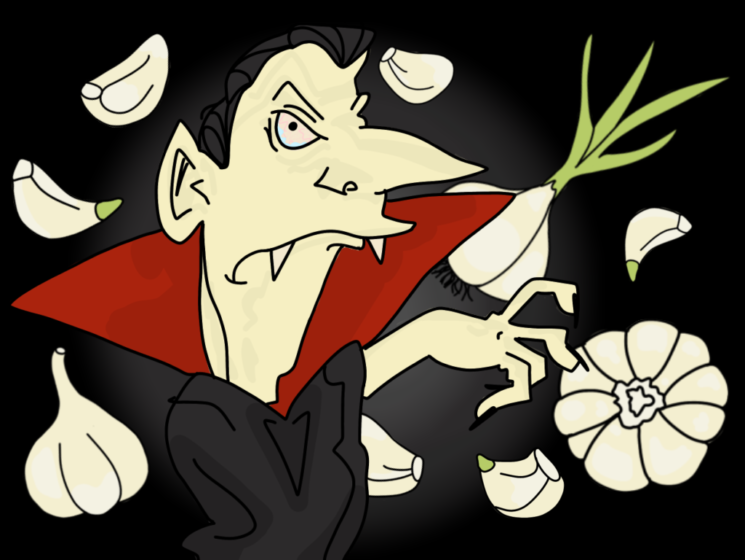
By Caroline Mora
Classic depictions of vampires teach us that all you need to keep yourself safe from vampires is some garlic hung and maybe a wooden stake. However, Popular shows like The Vampire Diaries and Twilight have shown us that maybe we have it all wrong. There might still be ways to ward off vampires, but it’s not the way we have been taught. To figure out the best ways to ward off a vampire, let’s analyze different ways that vampires have been viewed throughout history and hopefully, we will find our answer.
The concept of vampires originated in Bulgaria a little more than a thousand years ago. The Slavic vampires are referred to as “upir” and have no physical body, carrying themselves on the wind like spirits. According to myth, vampires did not drink blood or turn people with their bites. They were the explanation for the spread of disease or misfortune, often thought of on the same level as rats.
Common methods that the Slavic people used to prevent vampires were counting, and fire. Counting is in fact where the term “Count Dracula” came from. It was thought that when a vampire came across multiples of an item, it needed to stop and count the item. This would delay their advances against the townspeople and they would be stuck counting until the sun came up. Slavs would sprinkle mustard seeds, otherwise known as ‘eye of newt’ on their doorstep so if a vampire came by their home, they would be stuck counting the seeds. The fire, well it speaks for itself. Heat from the fire would repel the vampire and if they go too close, they would burn. Sunlight would work in a similar fashion. They would also turn to religious artifacts and faith to provide protection.
This lore was spread to the Western world by word of mouth. When the Holy Roman Empire took control of Hungary, soldiers took the Slavic legend to more metropolitan areas like Berlin and Vienna. Londoners heard this from Parisians and the Americas heard it from the Londoners.
As if you were playing telephone, the original folklore was twisted and exaggerated into something new. Instead of a spirit, the vampires were people who rose from the dead, having a tangible physical form. These living dead, if you will, needed to drink blood to survive. During this time, human blood was used for medicinal purposes so it made sense to the people of the 18th century that vampires were corpses that drank blood in order to come back to life.
As vampire folklore became more popular throughout the world, it took on many forms. Instead of a fearsome folktale told over the campfire, it made its way into horror literature. Bringing them out of the firelight and eventually into pop culture. There were poems, short stories, and books written about these creatures of the night.
Bram Stoker’s “Dracula” was published in 1897, and was the first mention of Count Dracula. This bloodthirsty character was actually inspired by a real person. Vlad Dracula was the prince of Wallachia (now part of Romania) and was well renowned for his brutal punishments as a military governor.
When doing his research on vampires, Stoker was fascinated with the tale of Vlad the Impaler and even named his character after him.
“Dracula” was a hit in 1897 and it is still a hit now. It is revered as a gothic literary classic, putting Stoker on the map along with other gothic writers such as Edgar Allen Poe and Mary Shelley. There have been a couple of film adaptations of his story, but there have also been many modern spins on the character as well.
More recently movies have been released where the vampire isn’t somebody to fear but to be loved. The Twilight Saga and The Vampire Diaries are film/television series based on their respective book series. The protagonists in both of these stories are human, and they fall in love with the vampire building a life and overcoming the challenges that come with their… “condition”.
In The Twilight Saga, vampires are able to stand in the sun without getting burned, or stabbed by a stake, and they are unbothered by garlic. The only way to defeat these bloodsuckers is to dismember them, which is only really done by other vampires. In The Vampire Diaries, the monsters follow pretty much the same rules as the classic idea of how to kill a vampire. Fire, sun exposure, a stake to the heart, and decapitation will all do the job but one item unique to this series is a plant called vervain. It is a purple flowering plant native to Europe and Asia, it has the ability to significantly weaken a vampire.
With all these different points of view, and ways to kill vampires, how do we know which ones will work the best? The most useful information can be found within the original Slavic folktale and similar tales told by word of mouth. The information included in and after Bram Stoker’s “Dracula” has probably been inflated and exaggerated to make the story seem more gothic to the audience.
In conclusion, the best way to keep a vampire out is to build a huge wooden pyre outside of your home to signal that you are not to be messed with. Or if you aren’t sure that you would like to build that, you could always sprinkle a little mustard seed outside of your door. I hope you all heed my advice and don’t get bit!





